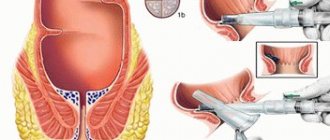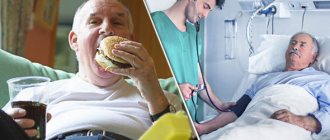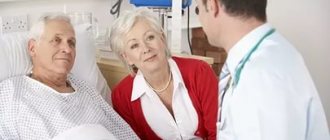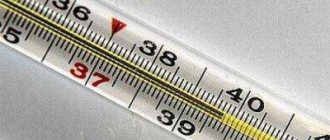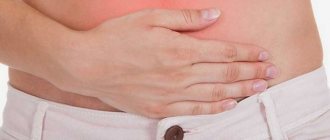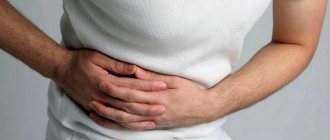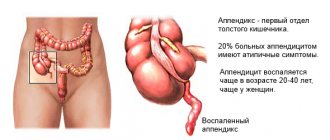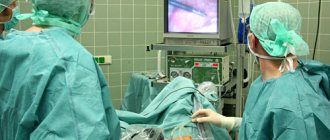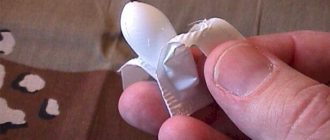Appendicitis is an inflammatory process of a small appendix of the blind part of the intestine. It is called the appendix, or vermiform appendix. This type of inflammation requires surgical treatment, which consists of removing the damaged intestinal process. The patient is operated on as an emergency. With timely treatment, this surgical intervention is successful with a minimal likelihood of any complications.
After the operation to remove appendicitis, experts recommend paying careful attention to the recovery period. If a patient after an appendectomy conscientiously and on time follows every doctor’s instructions, then the likelihood of complications is low and recovery occurs quickly. Otherwise, repeated surgical interventions will be required.
Features of rehabilitation after appendicitis removal
Let's consider what kind of rehabilitation is necessary after surgery for appendicitis, and why it is carried out.
According to modern data, the appendix has lost its original functions and is a vestige. This is a small (7-10 cm) dead-end section of the cecum; its inflammation is called appendicitis.
There are two types of operations to excise it:
- abdominal - with an incision in the peritoneum;
- laparoscopic - with several small incisions through which instruments are inserted.
Rehabilitation after removal of appendicitis using laparoscopy is easier due to the smaller size of the sutures and damage to the skin.
With any type of operational activity, the following occurs:
- receiving anesthesia;
- cuts and sutures on the intestines and blood vessels;
- skin damage;
- general body stress.
The recovery period, which includes:
- Postoperative nursing care. The patient should begin to move and get up at the recommended time, and receive drug therapy to avoid infection. To reduce severe pain, anesthetics are prescribed - first in injections, after discharge - in tablets.
- A special diet helps relieve stress on the injured intestines, improve digestion and normalize stool.
- Normalized physical activity protects against excessive effort, but stimulates blood circulation and accelerates metabolism.
The duration of rehabilitation after appendicitis in adults depends on the type of operation, characteristics of the body and much more.
Important: the recovery period is an essential part of the treatment of appendicitis; the success of this stage depends more on the patient than on the doctor.
Postoperative complications
Postoperative complications are newly emerging pathological processes that are not characteristic of the normal state in the postoperative period. They cause disruption of life and lead to death.
These problems arise when the doctor’s recommendations are not followed, prolonged physical inactivity, increased physical stress on the peritoneum and poor nutrition. It is important to remember that age and comorbidities also play an influential role.
Complications of surgery for appendicitis rarely depend on technical errors. More often the cause is late treatment.
Most of them are prevented only by timely assistance, rationally and correctly implemented recommendations of the attending physician.
You should go to the hospital if there is the slightest sign of complications. It is important to try to move less at this moment, ask someone from your family to help with the trip, or simply call an ambulance.
Classification
After an appendectomy, the following postoperative complications are possible:
- Prolonged elevated body temperature (38 and above);
- Bleeding and hemorrhage from the wound;
- Bedsores;
- Formation of infiltrates, fistulous tracts or abscesses in the abdominal cavity;
- Suppuration of a postoperative wound;
- Dehiscence of the appendix stump;
- Wound eventration is the exit of abdominal organs through a defect in its wall;
- Local or diffuse peritonitis;
- Thrombosis and embolism;
- Pulmonary complications;
- Intestinal obstruction;
- Cardiovascular complications;
- Acute renal failure;
- Formation of adhesions.
Prevention
You can get rid of most complications and recover faster if you rationally and correctly follow the prescribed recommendations of your doctor.
To prevent recurrent deterioration of the condition, a number of preventive measures are carried out:
- Resistance to pain, which is a powerful stress factor that prolongs the postoperative period;
- Adequate position in bed;
- Proper care of the postoperative suture;
- Early activation of patients;
- Combating oxygen starvation and reduced circulating blood volume;
- Use of antibiotics;
- Breathing exercises, which will improve the function of the external respiratory organs and provide the body with oxygen;
- Sanitation of the trachea and bronchial tree;
- Adequate pain relief;
- Massage, physiotherapy;
- Using an anti-decubitus mattress.
Doctors recommend wearing an abdominal bandage after surgery because it will keep the abdominal organs in the correct position, protect the wound from infection, and reduce the risk of hernias and pain. In addition, it helps maintain mobility and does not limit movement excessively.
The quality of the suture material that the doctor uses plays a huge role.
Diagnostics
Diagnosis is based on the detection of pathologically altered indicators of the constancy of the internal environment in comparison with normal ones. Complications are characterized by the following general symptoms:
- Bad feeling;
- Anxiety;
- Pale coloration of the skin and mucous membranes;
- Depressive state.
Chills, high temperature, decreased diuresis indicate the purulent and inflammatory nature of the disease. But nausea with uncontrollable vomiting, flatulence, stool retention and the passage of gas, a decrease in blood pressure will indicate problems in the digestive system. The appearance of these symptoms will be the impetus for starting a re-examination of the operated patient.
During a medical examination of a patient with a suspected postoperative complication, his complaints are studied, a general examination of the body is carried out, and the functioning of the body is assessed. A thorough and attentive examination of the postoperative wound is a mandatory and necessary stage of diagnosis. Hyperemia, swelling, swelling, increased humidity and temperature, purulent or bloody discharge are signs of a developing complication. Subsequently, laboratory, X-ray, ultrasound and other examination methods can be used in diagnosis.
Terms of rehabilitation
After the operation, the patient is transferred to a ward, where medical workers monitor recovery from anesthesia and possible complications from its use. If there are no problems, after 8 hours the patient can carefully rise and move in bed.
In the first days, the patient receives anesthetics and antibiotics to exclude infection, and all his movements are controlled by nurses.
Laparoscopy is chosen if appendicitis is not complicated and there are no contraindications to its use. This is the most gentle intervention option. The patient can get up a day after the manipulation; in the absence of complications, discharge occurs on days 3-7.
The period of postoperative rehabilitation after removal of appendicitis by laparoscopy is 2, less often 4 weeks.
Abdominal surgery requires a longer recovery period. The usual period is a month. With accompanying complications, it may take up to six months to fully recover.
Symptoms of appendicitis
The main symptom of appendicitis is abdominal pain.
- Pain syndrome. Usually the pain is localized in the right groin area, which immediately suggests appendicitis. However, sometimes the disease can begin with Kocher's sign. In this case, pain appears in the epigastrium and can be relieved with drugs like No-shpa. Patients often confuse this onset of appendicitis with another attack of gastritis or chronic pancreatitis and do not consult a doctor. The pain may “go down” to a typical place (right groin area) after a few hours or even days.
- Nausea, possible vomiting and loose stools (usually once).
- Temperature increase. Typically, body temperature during appendicitis does not rise above 38.5°C.
- Deterioration of general condition. Weakness, fatigue.
Surgical symptoms
- Tense abdominal wall.
- Shchetkin-Blumberg symptom, which appears when the peritoneum is irritated. The surgeon palpates the abdomen, and the patient's pain intensifies when the doctor removes his hand from the abdominal wall.
Diet and rules of nutrition in the postoperative period
Hunger is indicated on the first day. In the future, diet is required, since the operation was performed on the intestines, which are involved in digestion. Basic nutritional rules that must be followed during the rehabilitation period after surgery for appendicitis:
- Meals are fractional - 5-6 times.
- In the first days, jelly, low-fat broths, and fermented milk products are useful.
- Food must be warm - hot and cold are not allowed.
- You should not eat foods that cause flatulence - legumes, cabbage, carbonated drinks.
- The best way to cook is by steaming.
- Heavy foods are excluded - spicy, salty, pickled, fatty.
- After eating, rest is necessary so that the body's forces are directed to digestion.
It is necessary to monitor normal bowel movements. Constipation can be caused by intestinal obstruction caused by poorly performed surgery. In the first month, it is better to give preference to pureed, boiled food.
If you are prone to constipation, diet and nutritional rules must be followed with special care.
Please note: drinking alcoholic beverages is possible 1.5-2 months after surgery, if no complications arise.
For men, the greatest difficulties during rehabilitation after appendicitis removal are caused by giving up alcohol and heavy foods, which are considered traditionally masculine.
Treatment of appendicitis
Surgery is being performed. During classical or laparoscopic surgery, the appendix is isolated and removed.
The patient's refusal to perform surgical procedures can lead to rupture of the appendix and leakage of inflammatory contents into the abdominal cavity. This will cause peritonitis, which will have to be difficult and long to treat, sometimes even fatal.
Physical exercise
The postoperative period is characterized by low mobility, violations of the integrity of blood vessels lead to increased blood clotting and the formation of blood clots. Most doctors believe that dosed exercises help relieve many rehabilitation problems.
Physical therapy (physical therapy) is part of recovery methods. Together with physiotherapy, it improves metabolic processes, stimulates blood circulation, tones muscles and blood vessels.
Exercises are prescribed while on bed rest. Shown:
- bending the legs at the knees;
- turns of the feet and hands;
- breathing exercises;
- other exercises that do not affect the abdominals.
Usually after 3 days the patient can get up. To help the abdominal muscles, many patients are recommended to wear a bandage. The stomach should be protected from excessive tension when coughing and other tremors.
In the future, the increase in physical activity occurs gradually. For the initial 2-3 months, the best way to recover is walking. It is better to walk in parks, where there are good, smooth paths and fresh air.
An important part of rehabilitation is strengthening the immune system. The doctor may prescribe special means to increase it.
Lifting heavy objects weighing more than 3 kg is prohibited. You should not perform work that requires excessive effort and tension in the abdominal muscles.
For rehabilitation after removal of appendicitis, swimming in the pool is indicated. It helps, without overstraining the body, to increase the overall tone of all muscles.
Please note: you can start having sex 2-3 weeks after surgery, if your health allows.
Why don't doctors recommend removing appendix for no reason?
The appendix is an organ that is not filled with any tissue (hollow), has the appearance of a vermiform appendix, and can reach from 7 to 11 cm in length. Appendicitis is an inflammation of the appendix. Appendectomy is an operation to remove appendicitis. The absence of an appendix in a person is not critical. For our ancestors, the organ played an important role - it helped in the digestion of roughage, but today it is considered rudimentary, i.e. having lost their original function in the process of evolution. But it is not completely useless; it performs an immune function (it acts as a barrier when bacteria enter the body, as their storage facility). The appendix contains lymphatic tissue, so the organ performs protective functions. There is no need to delete without reason, because... surgery can significantly weaken the immune system and lead to hormonal imbalance.
General information about possible periods of hospitalization
It would be imprudent to talk about specific and clearly defined periods of hospitalization after surgery for appendix removal. After all, each patient has his own body with unique immunity and resistance. This means that for one, everything can heal quickly and without complications, while for another, the temperature may rise or some other illness may occur after surgery. If any complications arise, local therapists will give you a long sick leave after appendicitis for recovery. By the way, this will even make many people happy.
The main factor determining the length of hospitalization can be considered the type of surgical intervention used. The following methods are used in surgery:
With this method, you will have to stay in the hospital for about 10 days, and with laparoscopic removal this period is reduced to 3-5 days.
When is sick leave extended?
How many days later will they be discharged if there are indications for extending the certificate of incapacity for work? Sick leave can be extended if the clinical situation meets the following requirements:
- complications during and after surgery, including rehabilitation (peritonitis, sepsis, abscesses, adhesions, thrombosis);
- an adult patient or child has disabled status;
- difficult recovery, impaired mobility after surgery.
To extend the certificate of incapacity for work, it is recommended to contact the head of the surgical department or clinic at your place of residence. The appeal must be oral or declarative in nature in accordance with the procedures of the medical institution.
The average extension period reaches 30 days, but in special cases, sick leave can be extended up to 12 months.
We invite you to familiarize yourself with how many acres of land a disabled person is entitled to
When to go to work
According to official medical standards, 2 weeks are allotted for the healing of a suture after appendicitis. Over the next 2 weeks, the body fully recovers. The total is 4 weeks, but these are averages. Sick leave for laparoscopy is issued for 5-10 days. After a complex abdominal operation, they are released from work for 15-30 days. If the postoperative period is aggravated, sick leave is extended for more than 30 days until complete recovery.
Recovery after removal of the inflamed appendage of the cecum takes 4-6 weeks. During this time, damaged skin and muscles grow together. To facilitate the post-operative interval and speed up healing, follow the doctor’s recommendations, take the necessary medications, and adhere to a diet.
We recommend: How to determine that appendicitis hurts - signs and intensity
Hospital stay
If the appendectomy was performed laparoscopically, the patient is discharged within 3-4 days. If an open operation is performed, a week or more later. Medical supervision is necessary to prevent complications.
Pain in the postoperative period is relieved with painkillers. If inflammation has spread, antibiotics are injected. After the intervention, it is necessary to monitor the patient’s body temperature. 37.5 °C is the norm; exceeding it indicates the development of complications.
A nurse does the dressings in the hospital. The wound is treated with 70% alcohol or iodine solution every other day. If drainage is installed, treatment is carried out daily. On the 3rd day, the drainage is removed, and the place where the tube is removed is sealed with a plaster.
Hygiene procedures are allowed 48 hours after surgery, but it is not advisable to wet the suture.
An important stage of rehabilitation is diet. The patient can use:
- light vegetable soups;
- lean meat;
- mashed potatoes;
- stewed vegetables;
- dairy products.
The goal of the diet is to restore intestinal motility. After the first stool, the diet is expanded. Products that provoke gas formation and suppress peristalsis (chocolate, sweets, baked goods, brown bread, legumes, fatty meats and fish) remain prohibited.
Rules and restrictions during rehabilitation
On the first day after surgery, patients fast. If you want to eat, you can drink thick jelly, broth with lean meat and vegetables. In the first hours after recovery from anesthesia, any drink or food is contraindicated (vomiting, asphyxia with vomit is possible). All food should be warm, at a comfortable temperature; aggressive foods with gas and high fat content are excluded.
Nutrition during the recovery period should be fractional, in small portions - this eliminates stagnation in the intestines, reduces the load on smooth muscles, and eliminates constipation.
You should also follow a few rules:
- avoid visiting saunas, baths, hot baths - a warm shower is enough;
- exclude exposure to ultraviolet radiation, direct sunlight (including visiting a solarium);
- exclude physical activity and heavy lifting;
- control stool - if you have constipation, you should take osmotic laxatives until stool passage is completely restored.
If the patient is sent home before the stitches are removed, they must undergo antiseptic treatment and bandages. An aqueous solution of Chlorhexidine, Furacilin, and Miramistin are ideal as an antiseptic.
If redness and pain appear on the wound or suture element, the wound becomes wet, your health deteriorates, or hyperthermia, you should consult a doctor. Such symptoms may indicate complications.
After returning home
After discharge, the patient should continue to monitor the suture. After a shower, it is treated with alcohol, iodine or brilliant green, and sealed with a band-aid. Sutures are removed on an outpatient basis, 10-14 days after surgery. After removing the threads, care remains the same. The bandage should be worn until the tissues are completely healed and the sanguineous discharge disappears.
The second aspect of rehabilitation is limiting physical activity. After laparoscopy, a strict regime is observed for 14 days, after open appendectomy - 1 month. During this time, any physical activity is prohibited, except for quiet walks and simple home activities (without active bending or sudden movements).
In the first weeks after discharge, the patient should continue to monitor his diet to prevent constipation and severe straining. The menu should contain a lot of vegetables, fermented milk products, and you must follow a drinking regime. If constipation occurs, consult your doctor about taking a laxative.
How will they operate?
Today, laparoscopic appendectomy is preferred. Especially in cases of obesity and diabetes mellitus, when large incisions are inappropriate. However, there are a number of contraindications for the method:
- more than a day from the beginning of the inflammatory process;
- suspicion of peritonitis;
- heart and lung diseases.
The minimally invasive method is less traumatic, is used if the operation must be performed under local anesthesia, and ends with a shortened rehabilitation period.
Laparoscopy is performed only as planned, when doctors have the opportunity to fully prepare the patient for the operation:
- collect anamnesis;
- select anesthesia;
- stop the inflammatory process.
Open surgery to remove the appendix is performed under general anesthesia. The duration of the intervention is 40-120 minutes, depending on the complexity of the clinical case. Preparation and final diagnosis are usually carried out simultaneously. Women should be examined by a gynecologist, and sometimes an ultrasound examination is performed. In case of constipation, the patient is given a cleansing enema. If he has eaten in the last 6 hours, the stomach is cleaned as an emergency.
Recovery period for complications
If complications occur that may appear during or after surgery, the patient's condition usually worsens on the second or third day. The patient complains of pain in the area of the incision, his temperature rises, general weakness occurs, and purulent discharge appears from the suture. The most common complications include:
- rupture of the appendix during surgery. The patient's condition is life-threatening;
- intestinal obstruction. Gas accumulation occurs, nausea and vomiting appear;
- the occurrence of adhesions and abscesses on the liver.
In this case, the doctor must quickly respond to the patient’s complaints. Sometimes repeated surgery or urgent therapeutic care is required. How long do they stay in the hospital after appendicitis with complications? Discharge of a patient from the hospital depends on the specific situation and the severity of the complication. The patient will have to stay in a medical facility until complete recovery.
